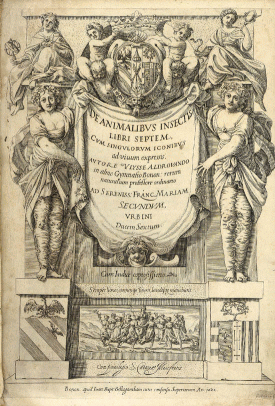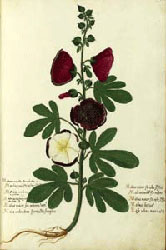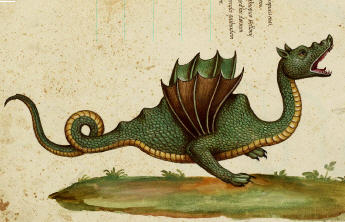Ulisse Aldrovandi (continued)
|
|
The careful and detailed work of collecting and preserving natural specimens led to the creation of one of the first Natural History museums, which Aldrovandi defined as a "theatre", or "microcosm of nature", where you could study 18,000 "different natural things" and 7000 "dried plants in fifteen volumes".
An important part of the collection was 17 volumes containing thousands of wonderful watercolours of animals, plants, minerals and monsters, and 14 cabinets (the Galleries) containing the printing matrixes for the illustrations of the printed volumes. These were an indication of Aldrovandi's awareness of the central role of the image as far as research is concerned. He believed that images were of great use in helping to spread knowledge, as they offered a true picture of "natural things".
Fig. 1: Flower from Vol. V of 18 volumes of watercolour tables commissioned by Aldrovandi from the mid-16th century onwards.
(Credit: Biblioteca Universitaria di Bologna - Archivio on line)
 |
Besides this careful and systematic research into and collection of elements of nature for his museum, he also undertook the large-scale project of organizing and reordering all this material. Those were the years in which frequent journeys to the new world brought to Europe things which had never been seen before, and so never described by ancient scholars. New names had to be found, and new classifications for all the things being discovered. Aldrovandi dedicated his whole life to this job; he compiled over 360 handwritten volumes on zoology, botany and mineralogy, many of which remain unpublished today. |
|||
Fig. 3: Front cover of the book "De animalibus insectis
libri septem cum singulorum iconibus ad vivum expressis" by Ulisse Aldrovandi published in 1602. |
Aldrovandi wrote his will in 1603. His last wish was that his complete scientific legacy, to which he had dedicated his entire existence, be left to the University of Bologna, which would have the duty to preserve it correctly, as a whole, in one place. Therefore, on his death in 1605, the town and the University of Bologna became the owners and guardians of the material and scientific legacy of this naturalist, considered by Linneo and Buffon to be the founder of modern Natural History.
4 May 2005 was the fourth centenary of the death of Ulisse Aldrovandi and was commemorated in Bologna with a rich programme of events. See: Centenarioaldrovandi.org
Useful links
![]() Celebrations for the 4th Centenary of the death of Ulisse Aldrovandi:
"Centenarioaldrovandi.org"
Celebrations for the 4th Centenary of the death of Ulisse Aldrovandi:
"Centenarioaldrovandi.org"
![]() Aldrovandi's theatre of nature
Aldrovandi's theatre of nature
![]() Herbarium of Ulisse Aldrovandi – University of Bologna
Herbarium of Ulisse Aldrovandi – University of Bologna
![]() Herbarium of the University of Bologna
Herbarium of the University of Bologna
![]() University of Bologna's Public Garden
University of Bologna's Public Garden
|
(Ulisse Aldrovandi - page 3 of 3) < Back | |


